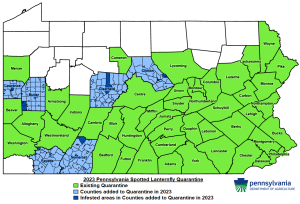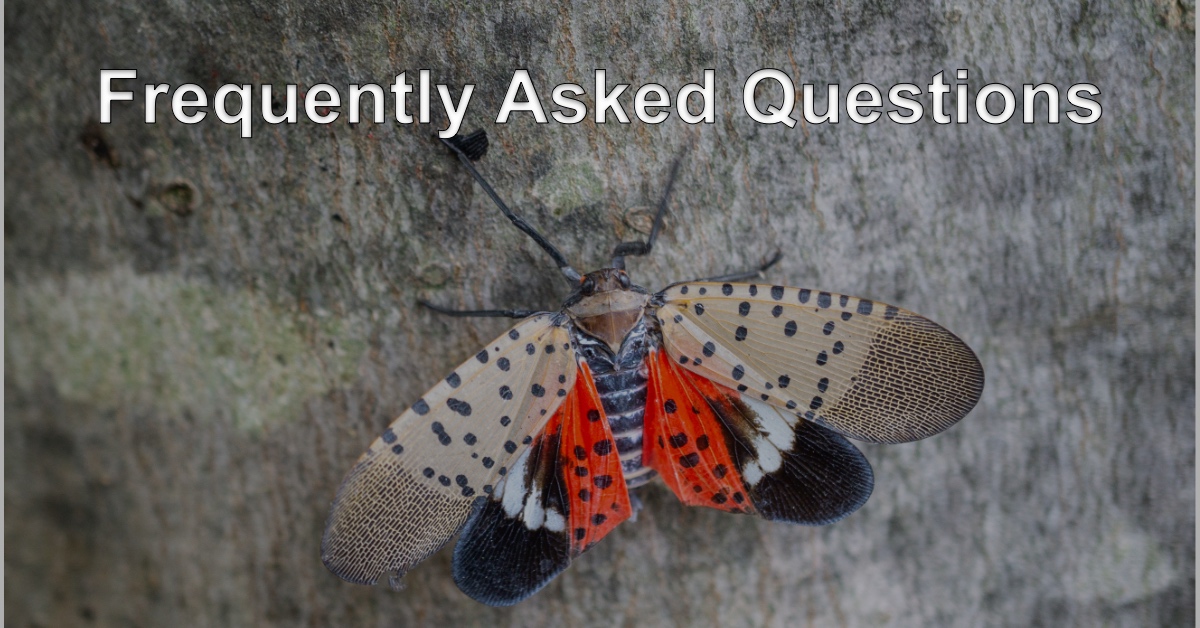Spotted Lanternfly FAQs
In this article, we’ll answer:
- What exactly is the spotted lanternfly?
- When did the spotted lanternfly get here?
- What is the government doing to stop the spotted lanternfly infestation?
- My trees have been treated for spotted lanternflies— why are they still on my trees?
- What can I use to kill spotted lanternflies?
- Do spotted lanternfly eggs die off in winter?
- Will spotted lanternflies infest all my trees?
- How long does your treatment for spotted lanternflies last?
- Will spotted lanternflies be back next year?
- What is the black goo spotted lanterflies leave all over the trees?
- How many treatments do I need to get rid of spotted lanternflies?
- What should I do if I see spotted lanternfly egg masses?
- Do spotted lanternflies bite or sting?
- Will spotted lanternfly treatments hurt my kids or pets?
- Why not just spray all trees for spotted lanternflies?
- Will spotted lanternflies kill my tree?
- How do I decide whether to treat my tree for spotted lanternflies?
- Is it a bad idea to plant new trees if I see spotted lanternflies?
The spotted lanternfly is raising more questions than answers, it seems. A widely-publicized infestation is sweeping across Lancaster County, causing concerned home and business owners to wonder what kind of action they should take.
Is it a plague that will kill all our trees? Can they be controlled?
Some unscrupulous companies are trying to profit by prescribing treatments that are environmentally dubious at best. While it is understandable that property owners wanting to get rid of them hire exterminators to spray the bugs, we believe the only responsible approach is to select and protect valued trees. (Calling an exterminator to kill bugs in your home is one thing. Having them spray an outdoor landscape, with bugs blowing in from the next county— will not get rid of them, but will have unintended consequences for the ecosystem, such as killing benign insects.)
So we’ve put together this list of frequently asked questions, based on what our customers have been asking. And asking, and asking…
SPOTTED LANTERNFLY FAQs
What exactly is the spotted lanternfly?
The spotted lanternfly has wings but doesn’t fly much, because it’s what’s known as a plant-hopper. However, it can travel on the wind, and its egg masses travel over long distances when attached to vehicles, firewood – just about anything. Native to China, India, and Vietnam, the spotted lanternfly loves to feed on ailanthus (tree of heaven), which is itself an invasive species. Unlike another well-known invader from Asia— the emerald ash borer— the spotted lanternfly has an appetite for many of our native species, including maple, birch and walnut, as well as grapes and hop plants.
When did the spotted lanternfly get here?
First discovered in 2014 in Berks County, the spotted lanternfly has been moving in all directions since then, blanketing Lancaster County and continuing to spread.
What is the government doing to stop it?
In May of 2018, the Pennsylvania Department of Agriculture announced a spotted lanternfly quarantine, covering 26 counties, according to the PA Department of Agriculture’s Spotted Lanternfly Alert. In 2021, eight more counties were added to the quarantine, bringing the total number of Pennsylvania counties under spotted lanternfly quarantine to 34.

Businesses and organizations that move vehicles in and out of the quarantine zone must get a spotted lanternfly permit. Residents are asked to use this spotted lanternfly checklist before moving outdoor items such as travel trailers outside of the 26-county quarantine zone.
My trees have been treated— why are there still lanternflies on there?
The treatment doesn’t put a giant protective bubble over your property. The insects can still fly in from other properties. What the treatment does is protect your tree. When they try to feed on it, they die.
What can I use to kill them?
You should avoid home remedies to control spotted lanternflies, says Penn State Extension. The Internet is full of them, including dish soap, vinegar, salt, boric acid, vegetable oil, and more. They can harm humans, pets, and plants.
The best approach is to have your arborist apply a systemic pesticide that will remain in the tree and kill all insects that feed on it. This not only protects the tree but is better than indiscriminately spraying the landscape. We believe it’s impractical and environmentally unsound to spray the insects directly.
Do their eggs die off in winter?
No. The adults die, but the eggs survive.

Will they infest all my trees?
No. They are attracted to some trees more than others, even trees of the same species, for no discernible reason.
How long does your treatment last?
One growing season. So yearly treatment is needed.
Will they be back next year?
Yes.
What is the black goo all over the trees?
The bugs use a piercing-sucking mouthpart to tap into the tree’s fluids and excrete honeydew, or sugary water. This sugary substance encourages the growth of black sooty mold, which is harmless to people but attracts other insects. At a minimum, it is bothersome and unsightly, and at most, it can be damaging to the tree or the plants underneath it.
How many treatments do I need to get rid of spotted lanternflies?
This question contains a faulty assumption. As arborists, our mission is to protect your trees, not to eradicate spotted lanternflies from your property. In fact, there is no way to prevent the spotted lanternfly from moving onto your property, and we believe that should not be your focus.
By annually treating your most valued trees, we can protect them from the damage spotted lanternflies cause (and in the process, kill all of the insects that attempt to feed on the tree).
I can see what looks like egg masses. What should I do?
Scrape the mass using a piece of plastic or wood into a container of rubbing alcohol or sanitizer. If you feel like getting physical, you can squash the eggs to destroy them instead. To learn more, watch this video from Penn State Extension about destroying spotted lanternfly egg masses. Then, we encourage you to use the Pennsylvania Department of Agriculture’s spotted lanternfly reporting tool.
Do spotted lanternflies bite or sting?
No.
Will your spotted lanternfly application hurt my pets and kids?
No. Just keep them away from the tree for a couple of hours until it dries.
Why not just spray all trees?
Indiscriminate spraying is environmentally irresponsible. Insecticides will kill not just spotted lanternflies, but beneficial insects in the ecosystem such as butterflies.
Will the spotted lanternfly kill my tree?
There is no documented case of the spotted lanternfly killing a mature tree. It is possible, though, that heavily infested saplings could die. However, heavy feeding by spotted lanternflies does weaken the tree and can make it susceptible to other maladies, such as secondary insects and diseases. When the tree’s defenses are down, secondary pests can come along and kill the tree. So while it’s not a tree-killer like the emerald ash borer is to ash trees, it is bad for the tree and should be controlled.
How do I decide whether to treat my tree?
It depends on how you value your tree. We can come out and discuss the situation with you to help you decide.
Is it a bad idea to plant new trees right now?
No. Chances of any individual tree becoming infested are not high. And every tree, even a newly planted one, can be treated if necessary. The treatment is not bad for trees of any age.
###



